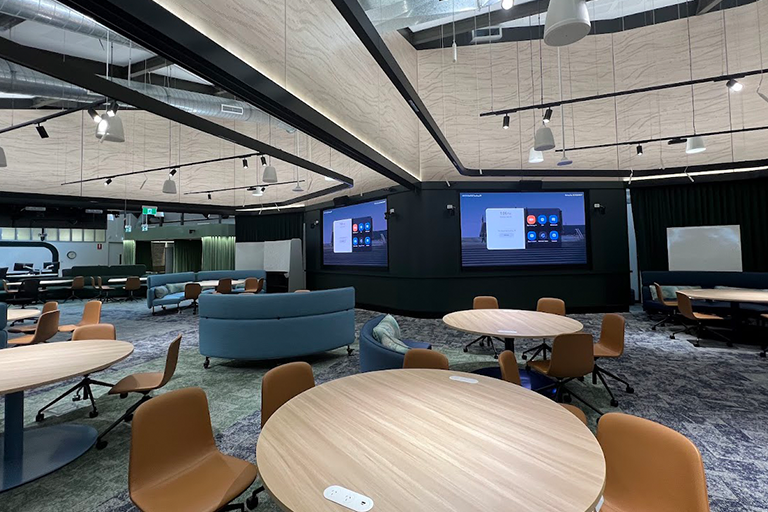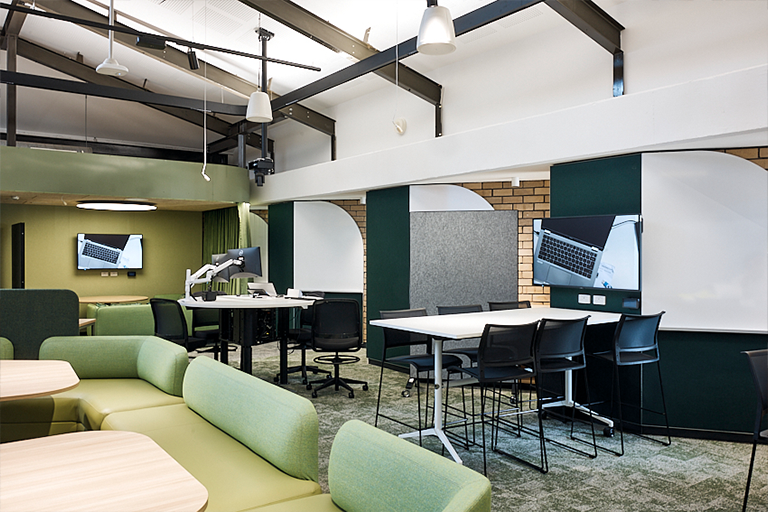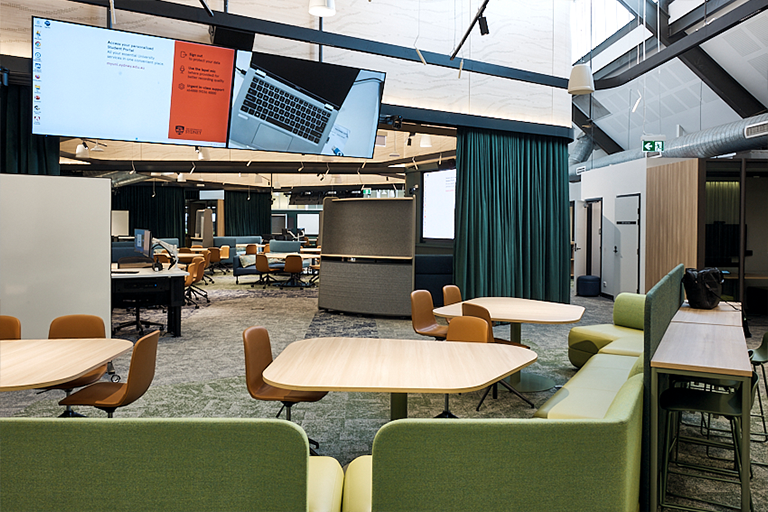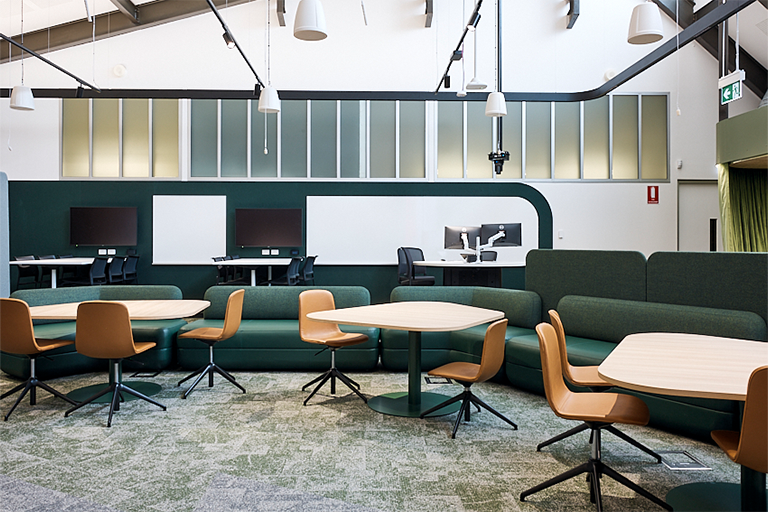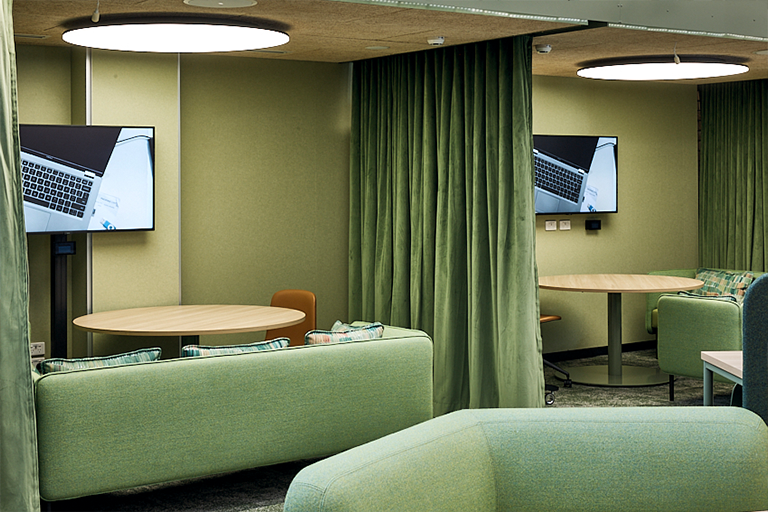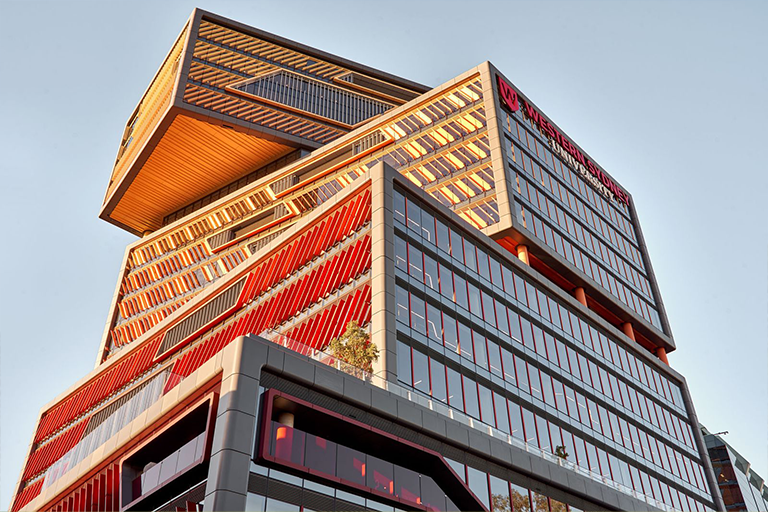University of Sydney - J02 CLaS Business School
Date
2024
Category
EducationAbout This Project
The University of Sydney’s Connected Learning at Scale (CLaS) Business School project embodies a groundbreaking educational initiative focused on scalability, personalisation, and collaboration. Crated to equip students for the swiftly evolving digital realm, this ingeniously conceived, multifaceted environment epitomises innovation and adaptability.
Achieved through the combining of two existing spaces, Room 310 & 311, this refurbishment has allowed for a specialised multi-purpose space with a system that supports three key pedagogical modes: Launchpad for mini-lectures, Huddle for independent quadrant-based seminars, and Focus for smaller group work and collaboration.
This project leverages the Q-SYS ecosystem for comprehensive control over audio, video, and cameras, ensuring a seamless and reliable operation.
The Three Modes
Launchpad Mode
Launchpad mode is intended to function as a single (whole room) “mini-lecture” with both presentation and discussion capability for all participants. Presentation includes the sharing of content sources and the presenters voice throughout the space and remotely. The discussion component encompasses the allowing of all participants, whether present or remote, to hear questions and comments made by others.
Huddle Mode
Huddle mode divides the space into four geographically independent quadrants whilst affording the same functionality as Launchpad mode. Each quadrant can act as an independent seminar room, with the spaces divided by an automatic drape system.
Focus
Focus mode adjusts the system to accommodate smaller group work/tutorial activities with a mix of settings including tables and whiteboards, seated areas for digital content, and booths for digital content and remote collaboration.
Technology Implementation
Equipment as well as platform selection was integral to ensuring a supportable, robust and reliable system that could work at scale, as well as sub-divided, was delivered.
Audio
The space has a high sloping ceiling with lighting and HVAC services throughout. The space required significant acoustic treatment to reduce the reverberation time and acoustic reflections to support the use-cases. A mix-minus system with granularity to support each mode, as well as capable of covering the entire space was implemented. 50 x QSC AD-P6T pendant speakers were hung throughout the space, amplified by 6 x QSC CX-Q 4K8 network amplifiers to allow complete control of each channel for the mix-minus system to receive microphone inputs, as well as allow the shading of signals within and between quadrants.
The selection of microphones was considered at length due to high ceilings and need to avoid obscuring sightlines, whilst simultaneously supporting voice lift and serving as a trigger that could be leveraged for camera tracking. 50 x Audio Technica mics – a mix of cardioid and “UniLine” capsules – were run into the 8 x mic/line inputs of each QSC networked amplifier to then be ingested into the QSC Core 610 running the entire space, via QLAN.
Each quadrant also includes a Sennheiser wireless lapel mic for presenter speech to be distributed through to the appropriate loudspeakers, based on mode selection.
Small enclosed pods, effectively small glass windowed rooms were also developed inside the space for small group collaboration. Within each of these enclosed pods, a networked microphone and loudspeaker were integrated.
Video
Each teaching lectern has 2 x QSC NV-21-HU and 3 x QSC NV-32-H video endpoints, configured as either encoders or decoders to provide input for USB-C, HDMI, Resident PC, Zoom Room and PTZ Visualiser, as well as output to dual interactive preview monitors, content feeds to Zoom Room and connection to all of the rooms audience facing displays.
In quadrants 1 and 4, a pair of 86’’ NEC displays provide visibility for the presenter’s content, whilst quadrants 2 and 3 have a single NEC LED video wall to provide a central focal point in the space.
Distributed around the space are 26 x student pods, either open collaboration displays running Zoom Wireless for sharing, or enclosed pods with Zoom Rooms for sharing and conferencing. Each main display for pod screen has a QSC NV-21-HU video endpoint in decoder mode to receive content from any quadrants teaching point or student pod.
Teachers can “pull” students content and display it anywhere around the room, including to the far-end.
Cameras
To ensure that academics in the space could focus on what they do best, it was important that the camera system be completely automated, as well as support all room modes and routing requirements. Three QSC NC-12×80 network cameras were selected for the job of automatically focusing on a participant when they were presenting or asking a question within each quadrant. Two were positioned either side of the main display system, allowing the ability to seamlessly switch between active talkers, ensuring that the far-end never sees camera PTZ camera movements, which are typically a common complaint with camera tracking systems. Combined with the audience-facing pair, a dedicated presenter camera provides a front-facing shot to frame the academic when addressing the class from near the main displays.
In each of the enclosed pods sits a QSC NC-110 network camera, with its fixed lens leveraged to auto-frame the shot based on the number of people within the booth.
Control
The orchestration of all technology needed to come together in a cohesive way to ensure that the academics in the space see something both familiar, as well as empowering them with the advanced functionalities of the space.
Each quadrant has a QSC touch panel running the standard University of Sydney User Control Interface as a baseline, with advanced Q-SYS control programming, giving users the ability to set up their session prior to the start of class, with a mode selector to configure the system to support each pre-defined mode once they were ready to kick things off.
Selecting “Launchpad” at a quadrants interface establishes it as the master, locking out the other touch panel interfaces whilst enabling the sending of selected AV sources to all displays in the space. All microphones are open and can be heard throughout the entirety of the space, including the enclosed pods, and all cameras are available to automatically route back at the master presenter station.
“Huddle” mode splits the room into four quadrants with motorized drapes on rails, allowing each presenter station independent control and automated routing of the local displays, microphone, speakers, and cameras in the quadrants. These quadrants can be operated by different academics simultaneously for smaller student cohorts.
“Group” mode enables all touch panels in the space to operate independently and mutes the microphones in the space from the mix minus system so that focused work can be performed with minimal distraction from other spaces.
Brands Installed:
- QSC
- NEC Displays
- Williams Sound Hearing Augmentation
Awards
Inavate APAC Awards 2024 – Education Project of the Year FINALIST
Photo Credit: Hansen Yuncken & Concept AV Australia

